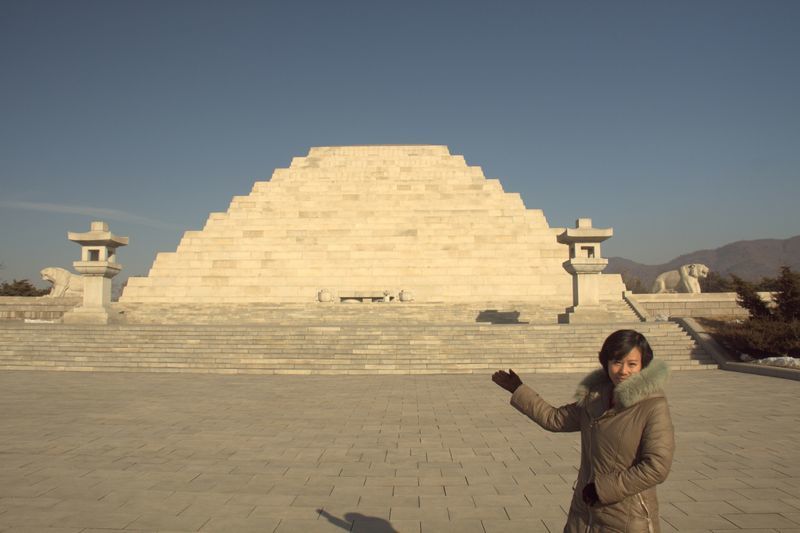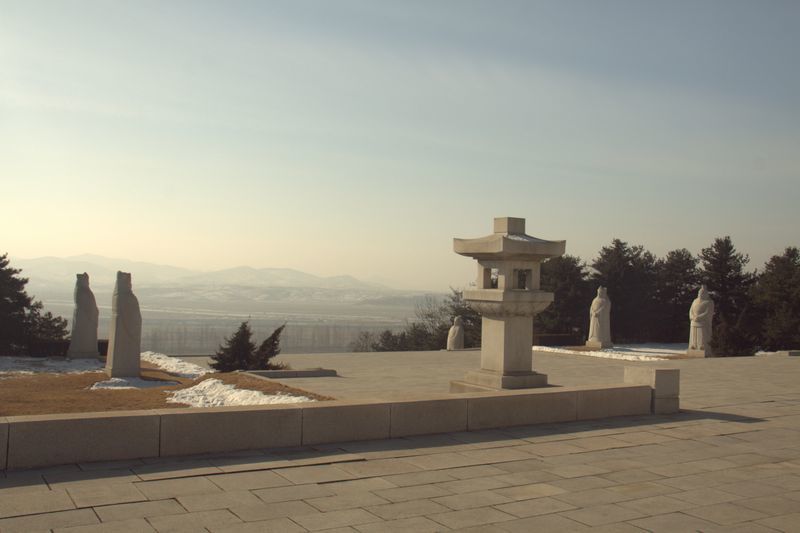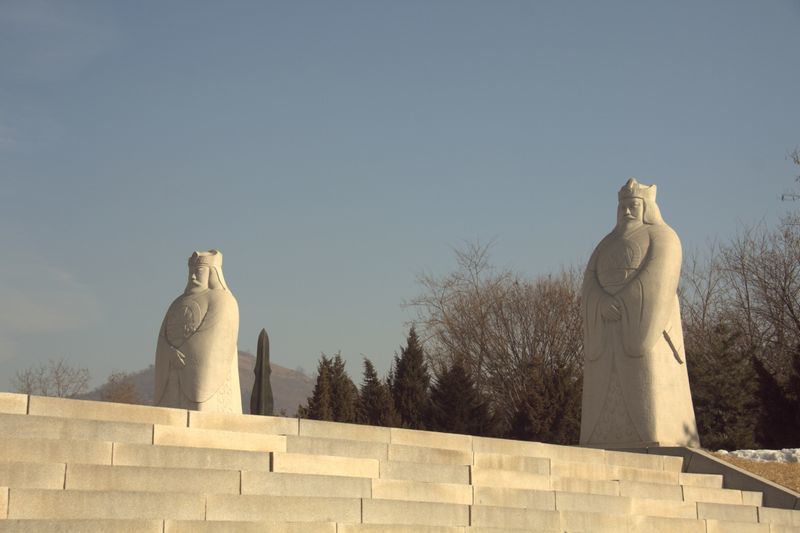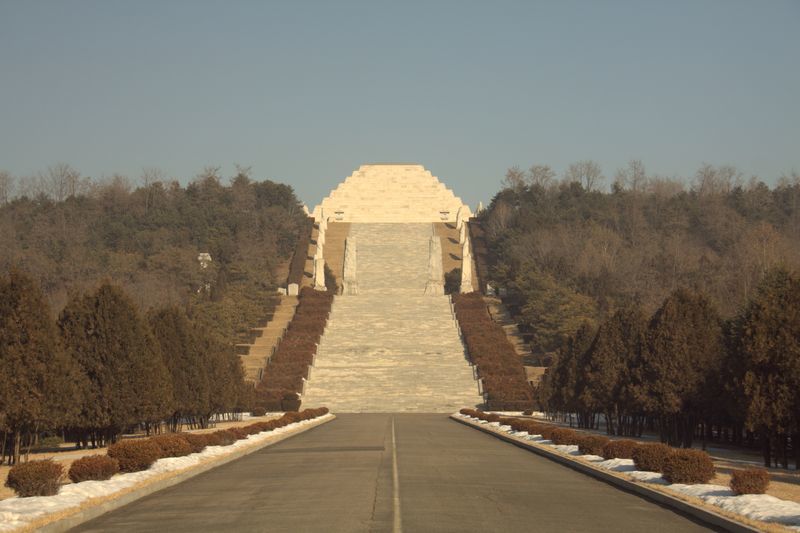Tomb of King Tangun | North Korea Travel Guide
Tomb of King Tangun
History
Tomb of King Tangun
Meaning & Symbolism
Visiting & Costs
King Tangun (also Romanised as Dangun), is a crucial figure from Korean history and mythology, known and venerated in both north and south.
His story starts in the distant past, involves anthropomorphized animals, ancient chronicles, political significance, and much more.

History
Tangun is known as the founder of the first Korean state; Ancient Choson (Gojoseon, in South Korean Romanisation).
He was more than just a man, and describing him as a God-king would be more accurate.
His early history begins with a story of a bear and a tiger (seen by many to represent different tribes of the time) who prayed to the son of the king of heaven, who was roaming the land at that time, to become human.
They were told to go into a cave and eat nothing but mugwort and garlic for a hundred days.
The Tiger couldn’t hack it and left, the Bear made it to the end and become a human woman. In great gratitude she became the wife of Hwanung (the son of the king of heaven) and gave birth to a child: Tangun.
On ascending to his kingly birthright, Tangun founded a capital in Asadal, considered (in North Korea at least) to be near today’s Pyongyang.
From there the glorious history of Korean stars begins.
This was in the year 2333 BC according to a 15th Century chronicle, the Dongguk Tonggam (so, writing 4 thousand years after the ‘fact’). Historians in both North and South Korea have since made efforts to locate the founding of Ancient Choson even further in the past and now some people will claim that the kingdom, and thus Tangun as its founder, dates back to around 3000 BC.
Details of day-to-day life in Tangun’s kingdom are sparse, but then it was a long time ago and records do slip down the back of the historical sofa from time to time, but to this day various festivals and notable occasions, mostly in South Korea, are marked on significant anniversaries related to the birth, ascension, and rule of Tangun.

Tomb of King Tangun
Around an hour from Pyongyang, along a very well-paved road, in an area known as Kangdong, the pyramidal Mausoleum of King Tangun can be found. This is not actually claimed as an original and was opened with great ceremony on 20th December 1994.
The story goes that Kim Il Sung was convinced that Tangun was a real historical figure rather than just a mythical story and that archaeologists were able to locate his tomb in 1993 after a long search. The structure was rebuilt (it is not really clear if the model for how it is now is how it was then) in 1994 white stones (and opened in the year 1994, how auspicious!).
The Tomb of King Tangun itself is pyramidal and rises to 22m high with a 50m wide base. Statues of King Tangun and his sons (also government officers and administrators) are here on-site as well as other minsters. At the opening ceremony, delegations of Chondoists (followers of a kind of native shamanistic religion) were invited from South Korea as well as the broader Korean diaspora and until recently South Korean adherents would go to Pyongyang on significant occasions to visit this tomb

Meaning & Symbolism
Aside from the obvious architectural numerology of the number of bricks in the tomb one of the main things that the location of this site does today is to add legitimacy to Pyongyang as the capital of North Korea.
If Tangun decided the capital was here, then this makes Pyongyang the real capital, right?
Also, Tangun was born of a bear and a God at Mt. Paektu, the sacred mountain of all Koreans, which is also in the DPRK, and was the site of both the Kim Il Sung-led guerilla struggle against the Japanese, and the official birthplace of Kim Jong Un; both of the ‘Mt. Paekdu bloodline’, a term used for the ruling Kim family.

Visiting & Costs
- Most foreign tourists do not go to the Tomb of King Tangun. The myth and history are not well-known in the non-Korean world. It is not high on the wish list of visitors to North Korea, and it is a bit too out of the way and not on the way to anywhere else to be justified for most people’s short trips to the country. However, for anyone with an interest in ancient history and legend, and for anyone wanting to try something a bit different or simply to go somewhere almost no tourists go this is a good option.
- The drive from Pyongyang can be up to an hour, but the road is good. There is a simple entry kiosk which sells a book about Tangun, and the local guide can tell some good stories about the king, his origins, and his rule.
- You can go inside the pyramid, it is small and not too much to see, but the tomb is in the centre. For an extra fee (a very high fee!) it can be opened and you can see the bones of Tangun.
- Before paying this fee though do realise that there is some disagreement (in the outside world that is, not in the DPRK) as to whether this really is the tomb of Tangun, or his bones, especially as he is quite likely to have been a mythical figure. He serves the same function at the intersection of myth and history as the Yellow Emperor in China, who also has a tomb that can be visited. Still, it doesn’t matter too much whether this is exactly Tangun himself or not, especially to the casual visitor, and no offence is taken if you simply wish to visit without the extra step of looking at an ancient skeleton as well. Most visitors to North Korea will be sophisticated enough to accept that there is a point at which all history gets tangled up in myth. If you can’t embrace such things and accept historical ambiguity then also avoid all Greek and Roman history too!

Interested in a tour to North Korea?
Travel to North Korea with the only
North Korea travel experts, Koryo Tours
North Korea Travel Guide PDF | Sign up to the mailing list | About Koryo Tours